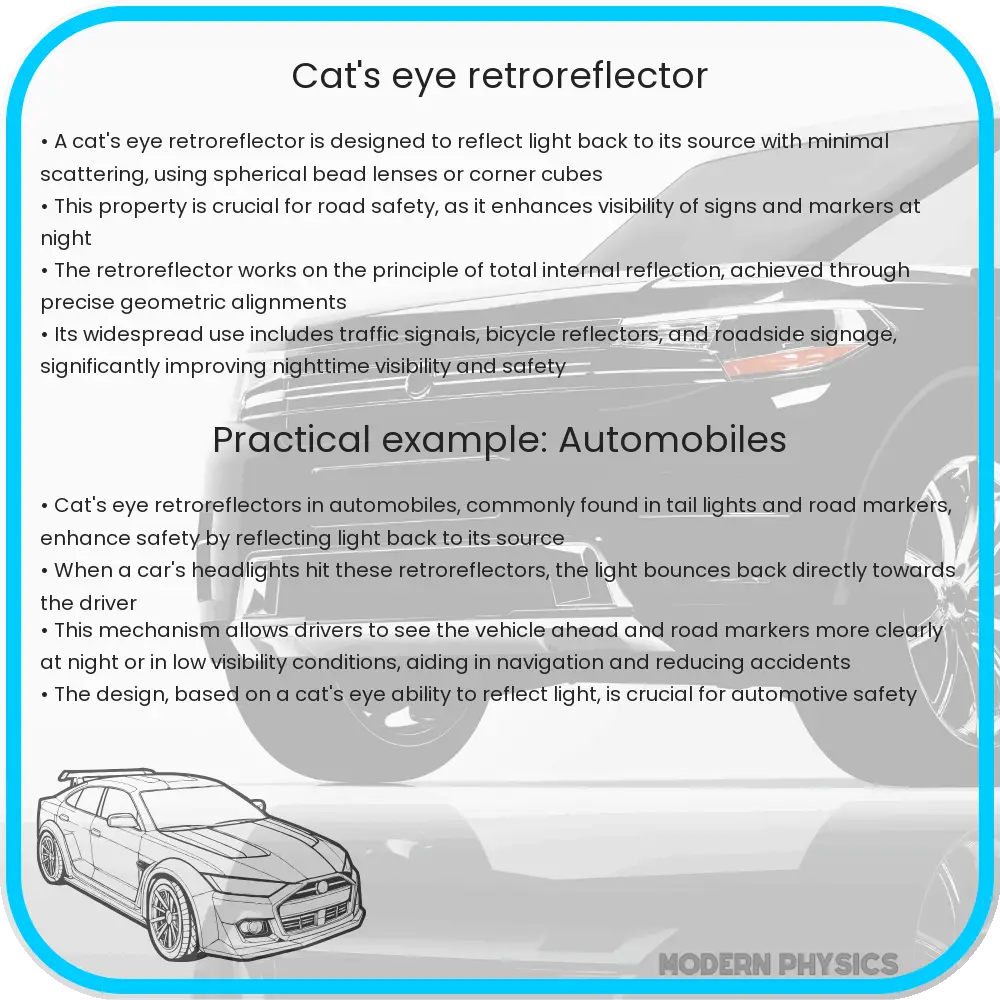Explore the Cat’s Eye Retroreflector: its operation, design, and key roles in safety and precision optics, along with future advancements and sustainability.

Cat’s Eye Retroreflectors: Enhancing Safety and Precision in Optics
The concept of retroreflection, where light rays are returned in the direction from which they came with minimal scattering, is a cornerstone in both safety and high-precision optical applications. At the heart of this technology lies the Cat’s Eye Retroreflector, a device ingeniously designed to optimize reflection regardless of the angle of incidence. This article explores the principles behind the Cat’s Eye Retroreflector, its applications, and the reasons for its superior performance in safety and precision optics.
Principle of Operation
Retroreflectors work on the principle of reflecting light back to its source with minimal dispersion. The Cat’s Eye Retroreflector achieves this through its unique structure, which mimics the ability of a cat’s eye to glow in the dark when light falls on it. This is accomplished using a spherical or cylindrical geometry, combined with a reflective coating on the rear side. When light enters the retroreflector, it strikes the reflective coating and is redirected back along its original path, irrespective of the incident angle.
Components and Design
The effectiveness of a Cat’s Eye Retroreflector lies in its construction. Typically, it comprises three mutually perpendicular reflective surfaces that form the corners of a cube. This geometric arrangement ensures that light entering the device is reflected back towards its source with high precision. The materials used for the reflective surfaces are critical for the device’s efficiency and durability. Commonly, materials like aluminum or silver are used for coating due to their high reflectivity.
Applications in Safety
Cat’s Eye Retroreflectors play a crucial role in enhancing nighttime visibility and safety on roads. They are widely used in traffic signs, lane markers, and bicycle reflectors. Their ability to return light to its source makes them exceptionally visible in low-light conditions, significantly reducing the risk of accidents. Beyond road safety, these retroreflectors are also employed in personal safety gear, such as reflective clothing for pedestrians and cyclists.
Significance in Precision Optics
In the realm of precision optics, Cat’s Eye Retroreflectors are indispensable for applications requiring exact light path control. They are pivotal in scientific research, including laser experiments where precise beam alignment is crucial. Moreover, their application in surveying instruments and satellite ranging systems underscores their importance in achieving high levels of accuracy and reliability in measurements.
Advancements and Technological Innovations
The evolution of Cat’s Eye Retroreflectors has been marked by significant advancements and technological innovations. Modern materials and coatings have enhanced their reflectivity and durability, making them more effective in various environmental conditions. Innovations in design have also led to the development of miniaturized retroreflectors for use in optical fiber technology and medical devices, where precision is paramount.
Environmental Impact and Sustainability
As with any technology, the environmental impact of producing and disposing of Cat’s Eye Retroreflectors is a consideration. However, efforts are being made to utilize materials that are more environmentally friendly and to design retroreflectors that are durable and have longer life spans. This not only reduces waste but also ensures that the safety and precision benefits of these devices are sustained over time.
Challenges and Future Directions
Despite their widespread use and benefits, Cat’s Eye Retroreflectors face challenges, particularly in terms of scalability and cost-efficiency in high-volume applications. Research is ongoing to address these challenges, with a focus on developing more cost-effective manufacturing processes and materials that do not compromise on performance. Additionally, the future of retroreflectors includes integrating them with smart technology, such as sensors and IoT devices, to enhance functionality and applicability in safety and precision optics.
Conclusion
The Cat’s Eye Retroreflector stands as a testament to the intersection of simple principles and sophisticated technology. Its role in enhancing safety on the roads and precision in optical applications cannot be overstated. As technology progresses, the potential for these devices expands, promising not only to maintain their current applications but also to pioneer new ones. The ongoing research and development aimed at overcoming existing challenges and improving the environmental sustainability of these devices underscore their importance in our daily lives and their potential for future innovations. In essence, the Cat’s Eye Retroreflector remains a pivotal component in the quest for safer, more precise, and environmentally sustainable optical solutions.
